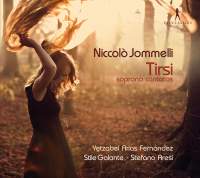Texte paru dans: / Appeared in: |
|
|
Outil de traduction (Très approximatif) |
|
|
|
|
|
Reviewer: Bertil
van Boer This disc is the first I know of that is devoted to the rather sparse number of secular cantatas he wrote, which is surprising considering his devotion to opera. The four works on this disc, all of which I believe are premieres, show that this neglect of a genre is unfortunate, for they are without exception at once dramatic, emotional, and musically intricate in displaying the nuances of the texts, all of which seem like miniature opera scenes. Dating them is, of course, problematic, and the modernity that peers forth does not necessarily support conductor Stefano Aresi’s contention in his fine notes that they are probably early works. More likely, they date from throughout his long lifetime, as they are stylistically more advanced than works written during his years in Naples or Rome at the beginning of his career. The music is sometimes quite effective. For example, in the opening work, Dido, the beleaguered queen of Carthage, rails against the faithless Aeneas. The opening aria is framed around a fandango, perhaps a holdover from the Spanish rule in Naples, but it lends a touch of the exotic. Her following accompanied recitative is spiced with tender moments and sudden harmonic twists, as the singer acts both as character and narrator. The final aria, a fuorore, lacks the brilliant display of the traditional seria, instead relying upon pointed shrieks (with no orchestral prelude to preface it) and suspenseful mezza di voces. The second cantata’s opening aria speaks of airing one’s sorrows, but the opening ritornello is gentle and lyrical, and reference to monsters and snakes only elicits some mild coloratura. If the text is not the driving dramatic force for Jommelli, certainly the plethora of singable vowels are, and this without any sense of irony. The aria “In fosca e near spoglia” from Partire conviene likewise is extraordinarily lyrical, with even more coloratura that leaps about in a sort of triple meter dance. The final aria from that cantata, “Se parli col mio,” is equally brilliant, light in tone and with a clear lyrical theme and jaunty accompaniment. The final cantata has a generic text by Pietro Metastasio, and Jommelli continues his light but lyrical style, here again focusing on the flexibility of the voice against a more dramatic text. But in the final aria, “Giura il nocchier,” the restless strings paint a picture of implacable waves that sailors (in love) must confront. One can practically feel the foam leaping off the wave tops, as the violins skip and dart. The only piece that seems out of place is the staid and predictable two-movement harpsichord sonata by Jommelli’s teacher, Francesco Durante. As adept as he was a vocal music, Durante seems more pedantic when writing for the harpsichord, but it shouldn’t disturb too much since this piece is obvious filler in between the pairs of cantatas. As for the performances, the overall disc offers unusual music in a nice package by a composer who should be better known to the world at large. The playing of the Stile Galante is always precise and well balanced. The ensemble is especially good, and the tempos are all in order. The sound is clear, and I am a fan of the laid-back continuo here, which allows for the upper voices to develop without interference. Cuban soprano Yetzabel Arias Fernández performs with good phrasing and a clarity that blends nicely with the strings. There are moments, particularly when she reaches for the upper registers, when there is a bit of shrillness, though this should not be too disturbing. All in all, a fine disc and one that does Jommelli credit. Recommended for those who want to see what the third pillar of the 1714 composers sounds like. | |
|
|
|
|
Cliquez l'un ou l'autre
bouton pour découvrir bien d'autres critiques de CD |
|




